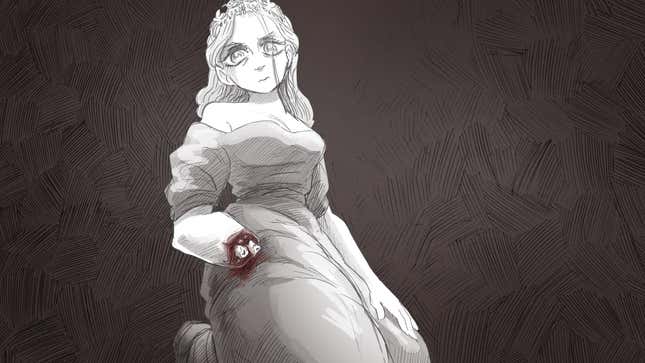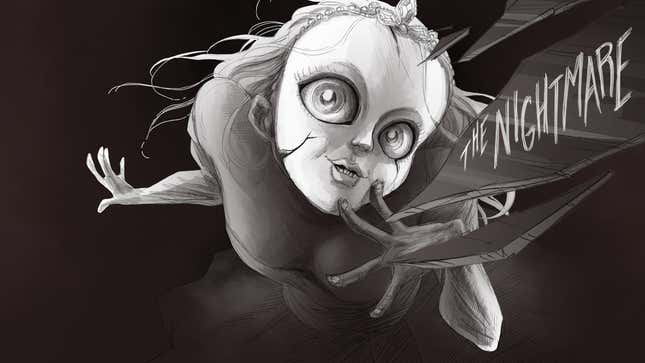
Every Friday, A.V. Club staffers kick off the weekend by taking a look at the world of gaming, diving in to the ideas that underpin the hobby we love with a bit of Game Theory. We’ll sound off in the space above, and invite you to respond down in the comments, telling us what you’re playing this weekend, and what theories it’s got you kicking around.
Like so many good horror stories, Slay The Princess both is, and is not, a metaphor. There is, undeniably, a princess locked up in the cabin that’s sitting in front of you when the game begins. You do, undeniably, have a voice screaming in your head that you’ve got to kill her, lest the world unceremoniously end. Figuring out what these basic concepts are meant to represent, then, is the “fun” of this new horror game—alongside making your way through multiple gorgeously gory illustrations of all the terrible things a Princess can do to you if she really sets her mind to it.
Created by Black Tabby Studios, and just recently getting a full release after putting out a powerfully evocative demo last year, Slay The Princess is, like the studio’s previous game, Scarlet Hollow, beautiful from the jump; all the art is from co-founder Abby Howard, who’s one of the more enjoyably unsettling horror artists working online of late, with an especial talent for depicting the soft, bulgy places where reality starts breaking down and other things begin to creep in. Those talents become readily apparent the deeper you go into STP, especially once it starts becoming clear that there’s more to its titular member of the monarchy than a strict damsel-in-distress act.
Structurally, meanwhile, the game plays out a bit like a visual novel horror version of The Stanley Parable, complete with a narrator (voiced, delightfully, by Jonathan Sims) who switches to hostile condescension at the first signs of defiance from the player, i.e., asking “Why does the Princess need to be slayed?” The game thus plays out as a series of extended dialogues, first between you and the Narrator, then you and the Princess, and eventually between you and yourself, as your unseen characters’ head starts getting filled up with mental remnants of past encounters with the woman in the cabin’s basement. (For instance, act as a gallant hero and you’ll start hearing The Voice Of The Smitten chime in with his romantic dreams; get utterly decimated and the sorrowful Voice Of The Broken will start offering its nihilistic thoughts. There’s a reason Black Tabby cites Disco Elysium as a touchpoint here.)

The level of responsiveness to player choice offered up by Slay The Princess is honestly a bit overwhelming, down to the vastly different ways the first encounter with the Princess can play out simply based on whether you chose to pick up a knife before heading down the stairs to confront her (turns out she doesn’t like it!). The more time you spend with Slay The Princess, the more winding and convoluted the labyrinth gets, even as the game works to signpost you toward following its slowly revealed structure. It’s the sort of game where you have to accept that you’re probably not going to see everything it has to offer, because Howard and co-creator Tony Howard-Arias have gone so far out of their way to make sure there’s too much “everything” to see. The first time a seemingly minor decision gets a callback several minutes later, or an early choice spirals far out of control into a whole new realm of horror, a bit of paralysis can settle in. What appeared to be a straight path to your destination suddenly reveals itself as a densely nested maze.
The rewards for traversing this dungeon of possibilities come in multiple forms: The art, obviously. (It can’t be overstated how well Howard’s sketchy, pencil-drawn style works to sell the game’s horror, especially as things trend from “unsettling” to “genuinely apocalyptic.”) The performances, too, with Nicole Goodnight joining Sims in doing great work voicing every iteration of a shockingly mutable character. And then there are the ideas the game is playing with itself: Thoughts on the ways perception shapes reality, the ways players are guided to interact with characters—especially female characters—in video games and other stories, and the ways we treat “choice” in narratives where players are free to rewind the clock and experience all possible choices. Some of this is well-trod territory, admittedly. (Stanley Parable is more than a decade old at this point, to choose just the most obvious reference point.) But they’ve rarely been explored with this kind of skin-crawling intimacy, as every decision is thrown back in your face—sometimes accompanied by your own organs. (There is a reason this is rated as both a psychological horror game and a dating sim on Steam.)
The net result is something that often feels genuinely uncomfortable to play, the metaphorical and literal sloshing around together in uneasy fashion—i.e., an effective dose of video gaming horror.